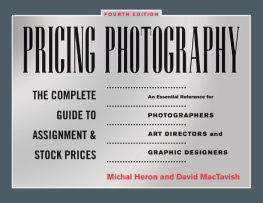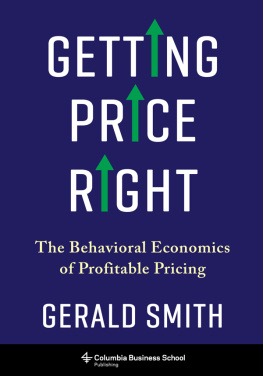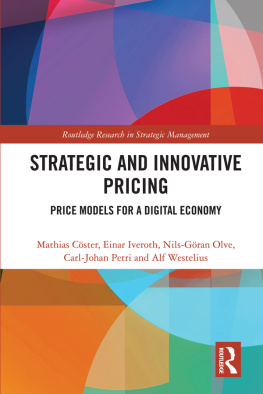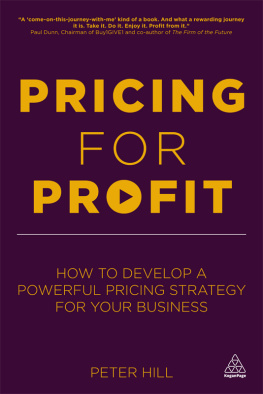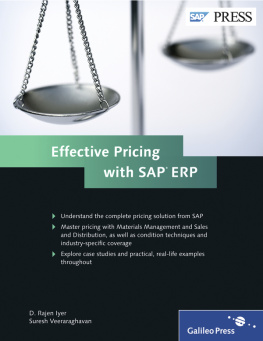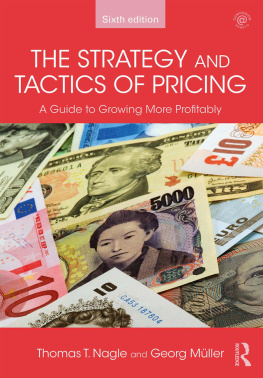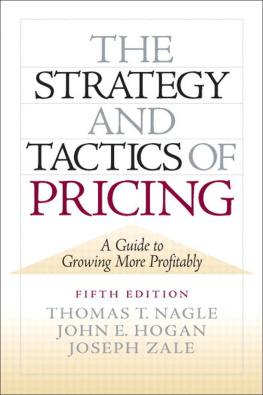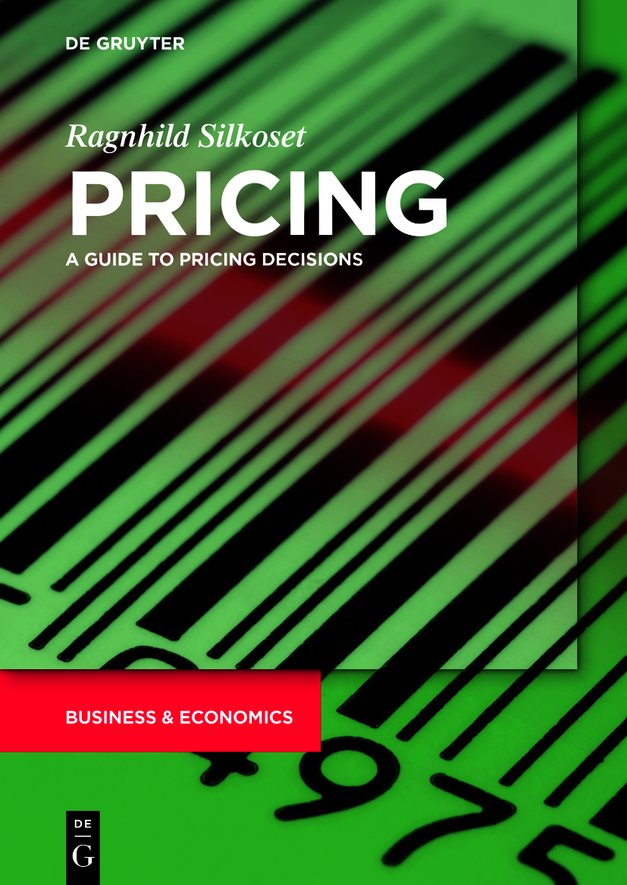The Deutsche Nationalbibliothek lists this publication in the Deutsche Nationalbibliografie; detailed bibliographic data are available on the Internet at http://dnb.dnb.de.
Introduction
Price is an important tool for a company to achieve its strategic goals. In this chapter, I describe different types of objectives for pricing policy. In times of crisis, the goal may be survival, while in good times, the goal may be growth and increased market share. Another objective may be to calm the competition, while a more aggressive objective may be to remove or take over a competitor. At the same time, there are surprisingly few businesses that are aware of how price strategy can be used to meet the companys strategic objectives.
Choice of Pricing Strategy
The most elegantly stated pricing strategy I know is from IKEA. They state: When we design the furniture, we start with the price tag. This is an important lesson that many other companies should listen to. Customers value products differently, and the question is not how much we have to pay to cover the costs of purchasing or producing the product. IKEA focuses on the costs that can be defended given the value and willingness to pay the customer segment has for IKEAs products.
Value-based pricing is often the recommended pricing strategy from a professional point of view (see ). The aim is to ensure customers are satisfied with the price they pay for the product, as well as the company being able to utilize the variation in the markets willingness to pay. To achieve such a pricing strategy, the company must identify which attributes of the products or services create unique value for customers. Making a distinction between price, value, and quality is important for handling prices in the correct way. This is because the price should reflect value. Price is often defined as meaning that the customer must sacrifice to obtain a product. Value is defined as the customers assessment of the usefulness of a product based on the perception of what you give and what you get in return. Quality, in turn, is about the fulfillment of the product or service attributes. The literature claims that a purchase is based on value and not quality. You cant disagree with that. I discuss this in the second chapter of this book.
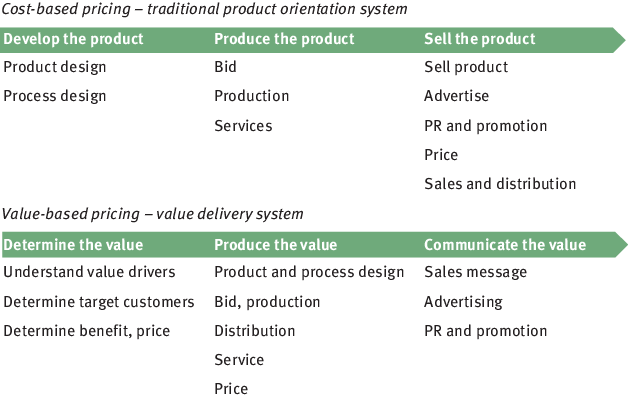
Figure 1.1: Different Objectives with the Pricing Strategy.
Cost-based pricing focuses on fair returns and hardly at all on the customers themselves [Cost-based pricing thus becomes a more reactive pricing strategy, where you do not sit in the drivers seat and lead your own price development.
With competitor-based pricing, the company sets the price close to the price of a specific competitor, and preferably a little below if they are a market challenger []. Such competitor-based pricing gives the competitor a full deck to play with, and they can control market access exactly as they wish. Lowering prices in markets that are not important to them, for example, forces other companies to earn even less money from these customers. In markets where the company has a clear and strong competitive position, customers will still prefer the competitor even though their prices are higher. Thus, the competitor also succeeds in these customer segments.
In the case of a customer-based pricing, the goal is to map the customers willingness to pay for the product during the purchase process. This is a standard strategy for car dealers, who often operate with a single price on the label for the car, but who have great freedom to lower the price and add additional equipment, all based on the information they pick up on how the customer reacts to the introductory price as well as on their ability to pay []. Thus, the realized price can deviate a lot from the actual price. The risk with such a pricing strategy is that the profitability is calculated based on list prices, while the realized prices can deviate a lot from this.
Pricing Strategy Matrix for New Products
A pricing strategy matrix looks at the price profiling of the company at an overall strategic level. The matrix sets guidelines for the customers perception of the companys ). This strategy lays the groundwork for entrepreneurs and for new product launches. Switching between the strategies afterward is difficult as the customers have already established an idea of where the company is in the price-quality map.
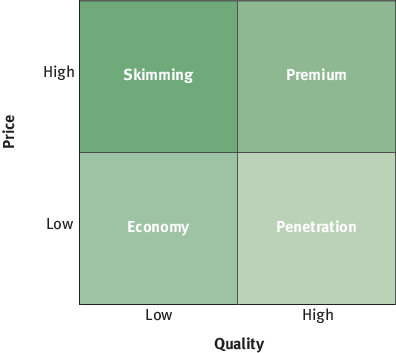
Figure 1.2: Price Strategy Matrix.
Pricing strategy for new products generally follows two paths, namely product skimming and product penetration []. A common mistake many make with innovations and new products is that they start the pricing planning too late. Price should be included as a development criterion at the very beginning of the production process and with the customers perception of value as a starting point.
Price Skimming Strategy
Price skimming is a demanding strategy as the company positions itself towards a sharp customer segment that requires extraordinary products and extraordinary performance. Prices in such a market are in the upper layer and are made possible through involved and interested customers who have low price sensitivity to new product launches. One example is customers who are particularly interested in fashion, and who are willing to pay high prices to get access to new trends. As the market matures, these garments reach a more price-sensitive market, and one switches to a more volume-based strategy. Another example is technology, where many customers are willing to pay extra for the latest models. The advantage of such a pricing strategy is that it is far easier to reduce the price in the future than it is to increase it.
The advantages of price skimming are that you have a high profit margin and quickly earn the development and production costs. Dealers, however, can also earn quick money and are a driving force in continuing with the strategy. Price skimming creates an experience of high-quality products.
The disadvantage of price skimming is that the competitors can reduce their prices and thus take over large parts of the market. This strategy can succeed only for small-volume sales. Also, former customers can be frustrated by the high introductory price. The strategy is not particularly cost-effective either.
Penetration Pricing Strategy
Penetration pricing follows a contrary strategy, where one prices the product lower than the economic value to the customer. This follows from the fact that customers have a high price sensitivity in the introduction phase, often because the product requires trialing before it is considered useful. In addition, these are products that are often exposed to strong competition immediately after being launched. The production capacity for such products is high, so that a high sales volume can be maintained. Penetration pricing is also used in many phases of a products life cycle by reducing the price sharply to meet new customer segments and their willingness to pay. Note, however, that a strategy where you reduce the price of products this much can make it difficult to increase the price again later. Correct and good information about customers price sensitivity is a prerequisite to succeed with this strategy. We also see that it is used in the retail industry: for example, Kroger and Costco implement a penetration pricing strategy for their organic products.


